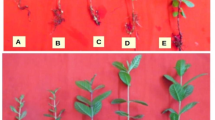Abstract
A nematode tentatively identified from its perineal pattern as Meloidogyne arenaria was found in a planting of Leucaena leucocephala at Crows Nest, Queensland. This is the first report of root-knot nematode on Leucaena in Australia. Further characterisation of the nematode using a standard differential host test confirmed its identity as M. arenaria race 2. Since most previous reports had suggested that Leucaena is resistant to Meloidogyne spp., L. diversifolia and L. leucocephala cw. Cunningham and Peru were tested in a glasshouse for their capacity to host Australian populations of M. javanica, M. incognita, and M. arenaria. L. diversifolia was susceptible to all species tested whereas L. leucocephala was resistant to M. javanica and M. incognita and susceptible to M. arenaria.
Similar content being viewed by others
References
Azmi, M.I. (1986) — Pathogenic effect of Meloidogyne incognita on seedling growth of su-babool, Leucaena leucocephala. Indian Journal of Nematology 16: 257.
Azmi, M.I. (1987) — Effect of Meloidogyne javanica on seedling growth of su-babool (Leucaena leucocephala). Nematologia Mediterranea 15: 383–384.
Brewbaker, J.I. and Hutton, M.E. (1979) — Leucaena. Versatile tropical tree legume. In New Agricultural Crops (Ed G.A. Ritchie), pp. 207–259. AAAS Selected Symposium 38, Westview Press, Boulder.
Esbenshade, P.R. and Triantaphyllou, A.C. (1985) — Identification of major Meloidogyne species using enzyme phenotypes as differentiating characters. In An Advanced Treatise on Meloidogyne, Vol 1. Biology and Control (Eds J.N. Sasser and C.C. Carter), pp. 135–140. North Carolina University Graphics, Raleigh.
Fargette, M. (1987a) — Use of the esterase phenotype in the taxonomy of the genus Meloidogyne. 1. Stability of the esterase phenotype. Révue de Nématologie 10: 39–43.
Fargette, M. (1987b) — Use of the esterase phenotype in the taxonomy of the genus Meloidogyne. 2. Esterase phenotypes observed in West African populations and their characterization. Révue de Nématologie 10: 45–56.
Harris, T.S., Sandall, L.J. and Powers, T.O. (1990) — Identification of single Meloidogyne juveniles by polymerase chain reaction amplification of mitochondria1 DNA. Journal of Nematology 22: 518–524.
Hartman, K.M. and Sasser, J.N. (1985) — Identification of Meloidogyne species on the basis of differential host test and perineal pattern morphology. In An Advanced Treatise on Meloidogyne. Volume II. Methodology (Eds K.R. Barker, C.C. Carter and J.N. Sasser), pp. 69–77. North Carolina University Graphics, Raleigh.
Hasan, N., Jain, R.K. and Patil, D (1983) — Expression of resistance in Leucaena leucocephala selections to rootknot nematode, Meloidogyneincognita. Leucaena Research Repods 4: 22–23.
Jepson, S.B. (1987) — Identification of root-knot nematodes (Meloidogyne species). CAB International. Wallingford, 265 pp.
Khair, G.T. (1987) — List of plant parasitic nematodes of Australia. Australian Government Publishing Service, Canberra. 156 pp.
Powers, T.O., Platzer, E.G. and Hyman, B.C. (1986) — Species specific restriction site polymorphism in root-knot nematode mitochondrial DNA. Journal of Nematology 18: 288–293.
Powers, T.O. and Sandall, L.J. (1988) — Estimation of genetic divergence in Meloidogyne mitochondrial DNA. Journal of Nematology 20: 505–511.
Sharma, R.D., Hutton, E.M. and Souza, F.B. (1985) — Reactions of some genotypes of hybrids of Centrosema species and Leucaena leucocephala to Meloidogyne javanica. Nematologica Brasillera 9: 23.
Thrower, L.B. (1958) — Observations on the root-knot nematode in Papua New Guinea. Tropical Agriculture Trinidad 35: 213–217.
Vincente, N.E. and Schroder, E.C. (1986) — Reaction of Leucaena leucocephala to populations of Meloidogyne incognita and M. javanica from Puerto Rico. Journal of Agriculture of the University of Puerto Rico, 70: 157–158.
Zimet, A.R., Quesenberry, K.H. and Dunn, R.A. (1986) — Evaluation of Leucaena species germplasm for genetic resistance to Meloidogyne incognita and M. javanica. Nematropica 16: 99–108.
Author information
Authors and Affiliations
Rights and permissions
About this article
Cite this article
Stirling, G.R., Stanton, J.M., Brandon, N. et al. Reaction of Leucaena to Australian populations of root-knot nematode (Meloidogyne spp.). Australasian Plant Pathology 21, 143–146 (1992). https://doi.org/10.1071/APP9920143
Received:
Accepted:
Issue Date:
DOI: https://doi.org/10.1071/APP9920143



